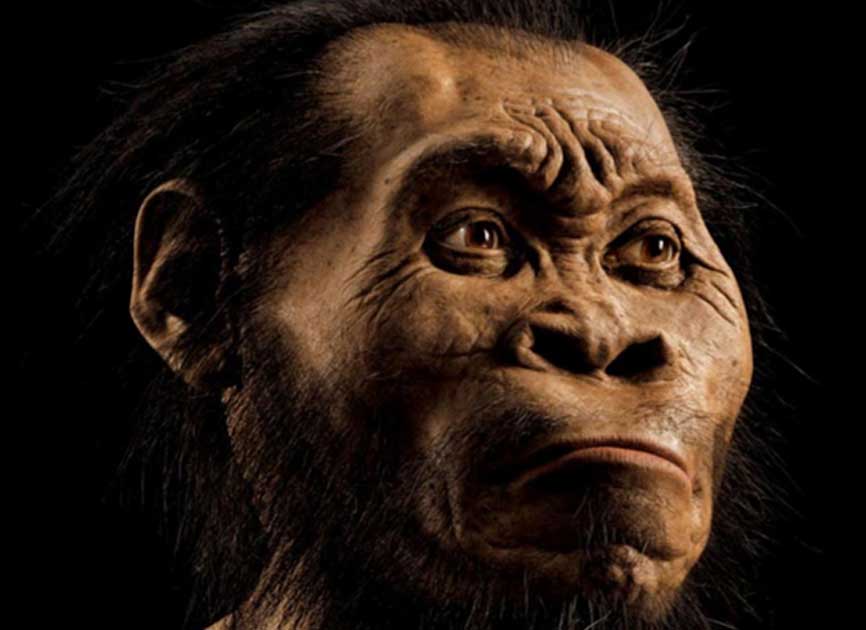Pre-human Species with Orange-Sized Brains May Have Used Teamwork and Buried Their Dead
Which came first in pre-human species’ communication and teamwork—larger brains or the folds and ridges of the brain that fostered language and empathy?
Some scientists studying a possible human ancestor , Homo naledi found deep in a cave in South Africa a few years ago, think the shape of the species’ ridges and troughs inside the frontal lobes of the skull, similar to the shape of modern human brains, may indicate advanced social skills.
H. naledi apparently cooperated to bury their dead in the cave, an effort they may have had to communicate about to achieve, says an article by Colin Barras about new research in New Scientist.
- Astonishing new species of ancient human ancestor found in burial chamber
- The Feet and Hands of Homo Naledi were Similar to those of Modern Humans – Could this be the Evolutionary Link Paleontologists Were Waiting for?
Lizleaflor reported for Ancient Origins in 2015 that the discovery of H. naledi was a major one, “set to change our whole understanding of ancient human ancestors and evolution, claim scientists. The bones of a new species of human relative have reportedly been found in a burial chamber in South Africa. Dubbed Homo naledi, the hominins are believed to have buried their dead—an advanced practice thought to have been limited to modern humans.”

Cartoon illustrating the geological and taphonomic context and distribution of fossils, sediments and flowstones within the Dinaledi Chamber, where H. naledi bones were excavated. (Paul H. G. M. Dirks et al/CC BY 4.0)
Lee Berger, a paleoanthropologist who led the work at the University of Witwatersrand in Johannesburg said: “We’ve found a new species that we are placing in the genus Homo, which is really quite remarkable.”
The scientists recovered remains of infants, juveniles, and an old adult—more than 1,500 fragments of bone belonging to at least 15 individuals. Thousands more pieces are still buried in the chamber, reported The Guardian .
The creatures possessed a small brain, about the size of an orange. They are said to have been long-legged, pinheaded and gangly, standing at about five feet (152 centimeters) tall, with the females slightly shorter.
Inside that “pinhead” with the orange-sized brain were folds and ridges that resemble modern humans’ large brains. As New Scientist reported this week:
“What excites the team most is a region on the side of H. naledi’s frontal lobe called Brodmann area 45, part of Broca’s area, which in modern humans has links to speech production. In this part of our brains, the pattern of gyri and sulci is very different from that seen in chimpanzees. H. naledi seems to have had our pattern, even though as an adult its BA45 was not much larger than that of a chimpanzee.”

Lee Berger with a replica of the skull of Homo naledi. (Reuters/Siphiwe Sibeko)
John Hawks of the University of Wisconsin-Madison told New Scientist:
“Some of the casts we are working on are the most extraordinarily preserved I’ve ever seen. The detail is just pristine. You look at the naledi cast and you think – holy crap this is just a tiny human. In our field, there is this dispute about whether the important thing in human brains is their size or the way they are organized.”
Hawks added that H. naledi seems to suggest organization is more critical.
The incomplete pieces of skull the scientists have found indicate it’s possible the bottom surface of the frontal lobes were expanded. This is an area associated with more advanced emotions such as empathy, says Shawn Hurst of the University of Indiana-Bloomington.
- Smarter Brains Are Blood-Thirsty Brains
- The Death of Lucy: Has a 3.2 Million-Year-Old Mystery Finally Been Solved?

The Homo naledi fossilized bones recovered from the Rising Star cave in South Africa. (Lee R Berger et al./CC BY 4.0)
These developments of the brains of the smallish pre-humans could explain why the tiny-brained people apparently felt emotional about their dead and started transporting bodies through a narrow, pitch-black cave system to a deep burial chamber.
The researchers seem to be taking as fact that the hominins buried their dead. While deliberate burial was given as very plausible a couple of years ago, other possibilities were listed. Berger and colleagues reportedly considered numerous scenarios to explain the location and treatment of the remains, including “mass death, an unknown carnivore, water transport from another location or accidental death in a death trap, among others. In examining every other option, we were left with intentional body disposal by Homo naledi as the most plausible scenario.”
Top Image: A reconstruction of Homo naledi’s head by paleoartist John Gurche, who spent some 700 hours recreating the head from bone scans. Source: Mark Thiessen/National Geographic
By Mark Miller



















